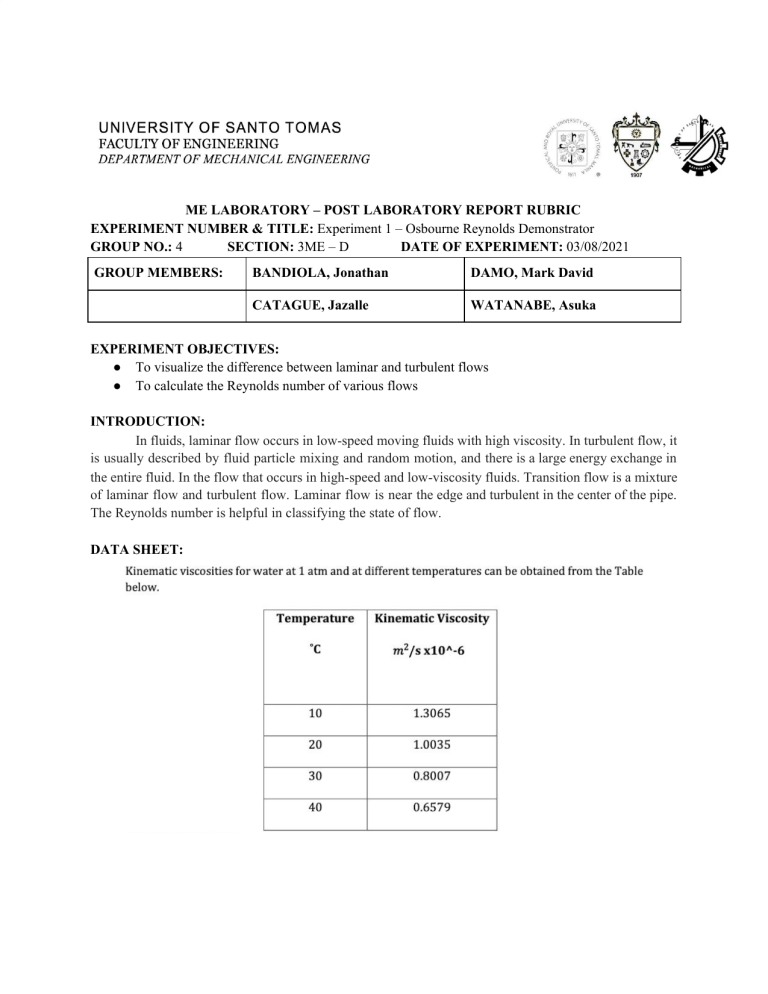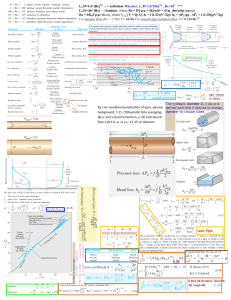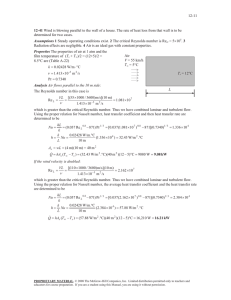
ME LABORATORY – POST LABORATORY REPORT RUBRIC EXPERIMENT NUMBER & TITLE: Experiment 1 – Osbourne Reynolds Demonstrator GROUP NO.: 4 SECTION: 3ME – D DATE OF EXPERIMENT: 03/08/2021 GROUP MEMBERS: BANDIOLA, Jonathan DAMO, Mark David CATAGUE, Jazalle WATANABE, Asuka EXPERIMENT OBJECTIVES: ● To visualize the difference between laminar and turbulent flows ● To calculate the Reynolds number of various flows INTRODUCTION: In fluids, laminar flow occurs in low-speed moving fluids with high viscosity. In turbulent flow, it is usually described by fluid particle mixing and random motion, and there is a large energy exchange in the entire fluid. In the flow that occurs in high-speed and low-viscosity fluids. Transition flow is a mixture of laminar flow and turbulent flow. Laminar flow is near the edge and turbulent in the center of the pipe. The Reynolds number is helpful in classifying the state of flow. DATA SHEET: Type of Flow Collected Volume Time Taken Temperature Laminar 200mL 18.19s 32.2°C Transitional 450mL 18.76s 31.8°C Turbulent 500mL 10.38s 33.4°C RESULTS, CALCULATIONS, and DISCUSSION: A. RESULTS: A.1. FOR LAMINAR FLOW: A.2. FOR TRANSITION FLOW: A.3. FOR TURBULENT FLOW: B. CALCULATIONS: B.1. FOR LAMINAR FLOW: B.2. FOR TRANSITIONAL FLOW: B.3. TURBULENT FLOW: C. DISCUSSION: Dimensions of the apparatus are utilized in the applicable calculations. If it happens to be needed, measure them to be able to be assure that they are accurate: Diameter of the test pipe: d = 0.010m Cross sectional area calculated: A = 7.853981634 x 10−5 m2 Each flow’s Reynolds number was calculated using the obtained data. Each flow showed the laminar, transitional, or turbulent flow. They're Reynolds numbers were all calculated, with laminar flow’s The Reynolds number is calculated as 1819.7866, and the laminar flow range entered is less than 2300. Laminar flow happens at low velocities, where the layers of fluid seem to slide by one another without distortion/ swirls present. For the transition stream, the obtained value is 3940.853926, and the range of transition stream is 2300 <x <4000. It can be observed that the dye stream will wander about and show occasional bursts of mixing. Finally, the Reynolds number of the turbulent flow is 8154.164422, and the incoming flow range is greater than 4000. Happens at higher velocities are called Turbulent flow. The increase in water flow changes the blue dye line. The change of the shape can be seen from a thin thread to slightly eddies, which include smooth thin threads and followed by a full swirl. This phenomenon does not happen suddenly, it can be observed that it varies from laminar flow to transitional followed by a turbulent flow. Until the flow is formed, the water inlet valve and outlet valve must be controlled. IMPORTANCE OF THE EXPERIMENT PERFORMED: Reynolds numbers provide engineers with instant information about the conditions that flow through streams, soils, and pipes. Applying proper relationships to help solve the problem at hand. For instance, the force acting on a ship that is being read in the lab for configuration purposes, then the Reynolds number of the flow acting on the model in the lab and the model on the field should be equivalent. CONCLUSION: Laminar, turbulent, or transitional are the characteristics of how a flow of fluid occurs. In an orderly manner with particles close to a solid surface acting in straight lines parallel to the surface is the movement of the fluid particles. If the value of Reynolds number is below 2100, it is called a Laminar Flow. In turbulent flow, the Reynolds number is greater than 4000. Also, it can be observed that in turbulent flow there’s a lateral mixing and the motion of the particles is inchoate. In the transition flow, the Reynolds number is between 2100 and 4000. We can conclude, the relationship between the water flow rate and Reynolds numbers is proportionate. Also, the function of the flow rate can be discovered in Reynolds numbers. REFERENCE/S: ● Lab Manual(Osborne Reynolds Demonstrator) ● Reynolds Number: Introduction and Definition of the Dimensionless Reynolds Number. Retrieved from https://www.engineeringtoolbox.com/reynolds-number-d_237.html ● Reynolds Number. (2016, September 7). Retrieved from https://byjus.com/physics/reynolds-number/




